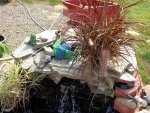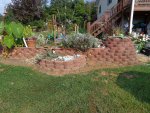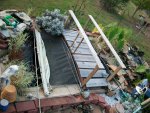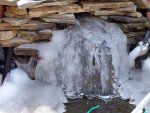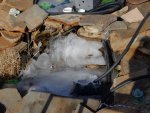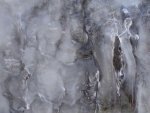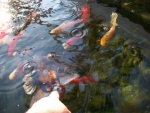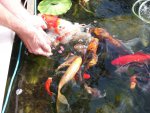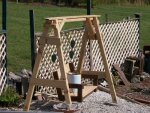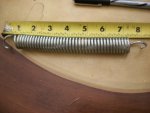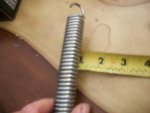t
I never thought about that either sissy. We don't lose too much here as the pond never gets too warm and the air doesn't get too cold but still I bet it happens some. Hey I wonder if
@callingcolleen1 's ponds are smaller in the top pond and then bigger to the two others? Maybe hers is hooked up different tho as they are pretty much separate ponds and only a tube of water pumps water to the other ones.
Good Grief I just typed for the last half hour and lost everything! where did it go?
OK here I go again!
When it comes to running ponds with many levels, I have of knowledge as I have been doing this for the last 25 years, and before I had the three big connecting ponds, I had five little connecting ponds. Now I am back to four big connecting ponds.
It should be noted that my very first connecting ponds, the bottom pond had a very small surface area that I was constantly topping up. It was so bad that If I was gone for a couple days camping with hubby, I would just leave the garden hose to very slowly drip in cause that is how dramatic the loss appeared. When in reality, the bottom pond surface area was about 40 percent smaller than the four upper ponds and that little pond was keeping four larger ponds topped up to maximum all the time. The ponds I currently have, the bottom pond surface area is as large as. or bigger than the upper level ponds.
I control the flow rates to each pond. If the power goes out I will lose some water out of the bottom overflow, and when the pumps start back up, the bottom pond will be down a few inches. That is why I have only the smallest fish in the bottom pond. I never would recommend putting the largest koi in the bottom pond like he does, cause the biggest koi need the freshest cleanest water cause they require the most oxygen. Bottom ponds tend to get lots of waste and the quality is not as good as the upper level ponds. It is really best to just have smaller fish in the bottom pond, trust me, been there done that for the last 25 years. The top pond also has no pump pumping water out, only a big pump pumping water in, and with no bottom drain, very little can go wrong. Water cannot be accidently pumped out, or dumped out threw drain.
Then the new upper pond has way more water volume, but the surface area is actually little bit smaller than the bottom pond. Depth does not effect the levels when the pumps are shut down, only surface area really counts. When the pumps are running at full speed, the second level pond holds an extra 1 inch of water, the third upper level has two pumps going into that pond, and holds an extra 1.5 inches of water, but the big pump going to the fourth upper level pond holds an extra two inches of water. So in total the water that would run off into bottom pond would raise the bottom pond by a maximum of about five inches. I can spare five inches of surface water in bottom pond should pumps go off in storm or something. At least the biggest fish will not be flopping around in a shallow bottom pond cause they will not suffer in the new upper level ponds. The upper ponds should not have a surface area any larger than the surface area of the bottom pond. Depth does not count, only surface area.
Then he talks about small fish going down into the bottom pond. Yes that does happen and I thought of that a long long time ago. That is why the biggest koi are in the top pond, and I have a water gate that only allows small fish to slip down to bottom pond. This way the upper two levels are just for koi, and no way can goldfish mix in that way.
Evaporation is greatest in the winter! When temps are very cold, like minus 40 below and water is barely above freezing, that is a big temperature difference and you get the "pot of boiling water on the stove effect!" Lots of water will be lost as stream rises from the open pockets of water. That is why I am careful not to over heat the pond and unplug the heater so I will get more ice coverage and less evaporation. Then lets not forget about water displacement in winter, as water from the bottom pond is turned into thick ice on upper level ponds. That is why I am always checking the water level in bottom pond when it is really cold outside,
Evaporation is also lost as the massive yellow flag water iris grows very tall. That big massive plant may be sitting in water but it drinks a lot when it is six feet tall and summer is hot! Hot windy days also cause more evaporation.
I do not have any splashy waterfall, only clean water drops that suffer much less evaporation than a waterfall. I use large spinning balls to get maximum circulation and oxygenation with minimal evaporation.
That guy is good, he is a pretty smart guy but all I have had is connecting ponds so I have lots of first hand knowledge after 25 years of running connecting ponds, and no way would I put my biggest koi in bottom pond unless the bottom pond was super big compared to upper levels. I find that the upper levels are super clean and fresh, and ideally the water should flow down to a marshy area that would be ideal for small fish. The marshy area (big yellow flag) cleans and collects lots waste from the water before it drops to final bottom pond.


